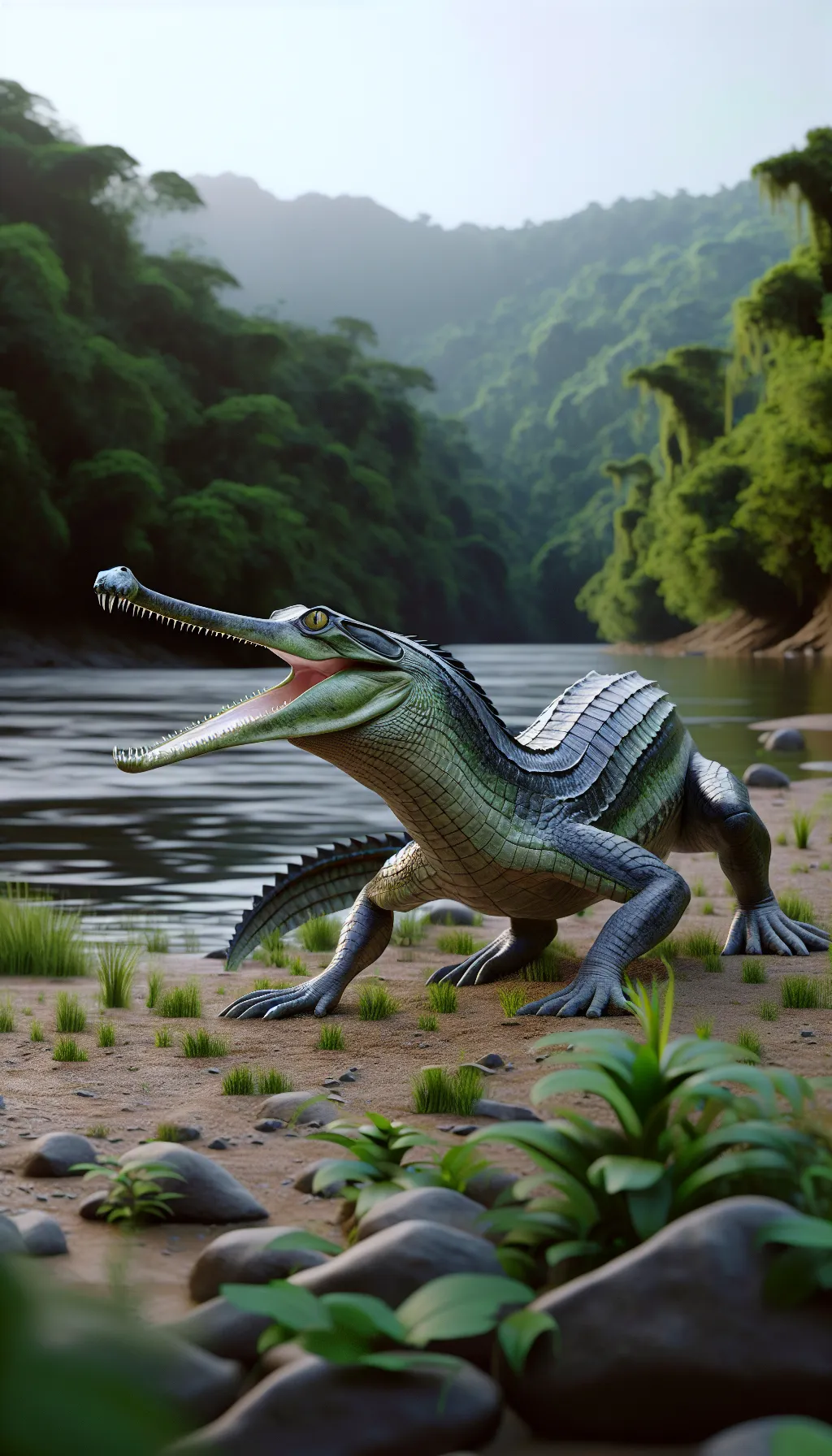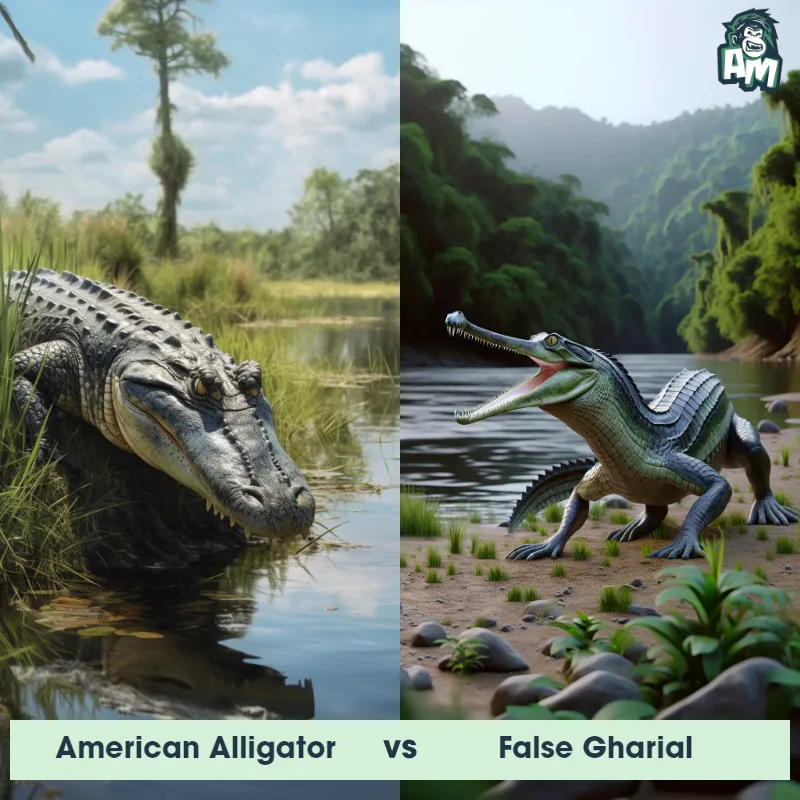The False Gharial
The False Gharial, also known as Tomistoma schlegelii, is a large, semi-aquatic reptile native to Southeast Asia. This species is often mistaken for the Saltwater Crocodile due to its similar appearance, but the False Gharial can be easily identified by its narrower snout and longer, slender body. It boasts a shiny olive-green to brown coloration, with light bands vertically aligned along its body, providing excellent camouflage in the water. The False Gharial has powerful jaws filled with sharp teeth, which it primarily uses to catch fish and small vertebrates. It can reach an impressive length of up to 5 meters 16.5 feet and is known for its agility and strong swimming abilities.

| False Gharial | |
|---|---|
| Size | Up to 5 meters (16.4 feet) (metric: 500 cm) |
| Weight | Up to 500 kg (1,102 lbs) (metric: 500 kg) |
| Speed | Speed: 10 mph (16 km/hr) |
| Key Strength | Powerful jaws and sharp teeth |
| Biggest Weakness | Slower movement on land |
| Scientific Name | Tomistoma schlegelii |
| Family | Crocodylidae |
| Habitat | Freshwater |
| Geography | Southeast Asia |
| Diet | Fish and other prey |
| Lifespan | 30 years - 60 years |

The False Gharial
The False Gharial, also known as Tomistoma schlegelii, is a large, semi-aquatic reptile native to Southeast Asia. This species is often mistaken for the Saltwater Crocodile due to its similar appearance, but the False Gharial can be easily identified by its narrower snout and longer, slender body. It boasts a shiny olive-green to brown coloration, with light bands vertically aligned along its body, providing excellent camouflage in the water. The False Gharial has powerful jaws filled with sharp teeth, which it primarily uses to catch fish and small vertebrates. It can reach an impressive length of up to 5 meters 16.5 feet and is known for its agility and strong swimming abilities.
Fun Fact: One fascinating fact about the False Gharial is that it possesses a unique adaptation that allows it to detect vibrations in the water. Located on its snout, this incredible sensory system helps the False Gharial easily locate its prey, even in murky or dark waters.
| False Gharial | |
|---|---|
| Size | Up to 5 meters (16.4 feet) (metric: 500 cm) |
| Weight | Up to 500 kg (1,102 lbs) (metric: 500 kg) |
| Speed | Speed: 10 mph (16 km/hr) |
| Key Strength | Powerful jaws and sharp teeth |
| Biggest Weakness | Slower movement on land |
| Scientific Name | Tomistoma schlegelii |
| Family | Crocodylidae |
| Habitat | Freshwater |
| Geography | Southeast Asia |
| Diet | Fish and other prey |
| Lifespan | 30 years - 60 years |
False Gharial Matchups
We use AI to simulate matchups between the False Gharial and other animals. Our simulation considers size, strength, and natural predatory behaviors to determine the most likely outcome.

Can't find the Matchup you want?
Create Your Own MatchupFalse Gharial: Diet, Predators, Aggression, and Defensive Behaviors
What do False Gharials eat?
False Gharials primarily feed on fish, although they have been known to consume other small vertebrates such as frogs, crabs, and insects. They are primarily piscivorous, using their long, slender jaws and sharp teeth to catch and consume fish in their aquatic habitats.
Do False Gharials have any predators?
As adults, False Gharials do not have many natural predators due to their large size and powerful jaws. However, their eggs and hatchlings are vulnerable to predation by larger birds, mammals, and reptiles that may feed on them.
Are False Gharials aggressive?
False Gharials are generally not considered aggressive towards humans or other animals, as they prefer to avoid confrontation and tend to be shy and timid in nature. They typically do not display aggressive behavior unless provoked or threatened.
Do False Gharials fight?
False Gharials may engage in physical disputes with one another, especially during mating season when males compete for dominance and access to females. These fights may involve displays of aggression such as hissing, snapping, and pushing, but actual physical combat is relatively rare.
How do False Gharials defend themselves?
False Gharials primarily rely on their natural camouflage, stealth, and aquatic habitat to avoid threats and predators. When threatened, they may use their powerful jaws and sharp teeth to defend themselves, delivering quick and accurate strikes to deter potential threats.
What is the biggest weakness of False Gharials in a fight?
Despite their intimidating appearance and powerful jaws, False Gharials are not well-equipped for sustained physical combat or prolonged land-based confrontation. Their large size and aquatic lifestyle may hinder their ability to maneuver efficiently on land, making them vulnerable to faster or more agile predators in such situations.
Fun Fact: Unlike many crocodile species that lay their eggs on land, the False Gharial constructs large, mound-shaped nests in the water using vegetation and mud. These floating nests provide protection from predators and maintain a controlled temperature and humidity level for the developing eggs.
Fun Fact: The False Gharial is one of the longest crocodile species in the world, reaching lengths of over 5 meters 16.5 feet. However, despite its impressive size, it feeds primarily on fish and rarely poses a threat to humans. This reptile prefers to remain in the water, where it is an excellent swimmer, specifically adapted for aquatic life.










